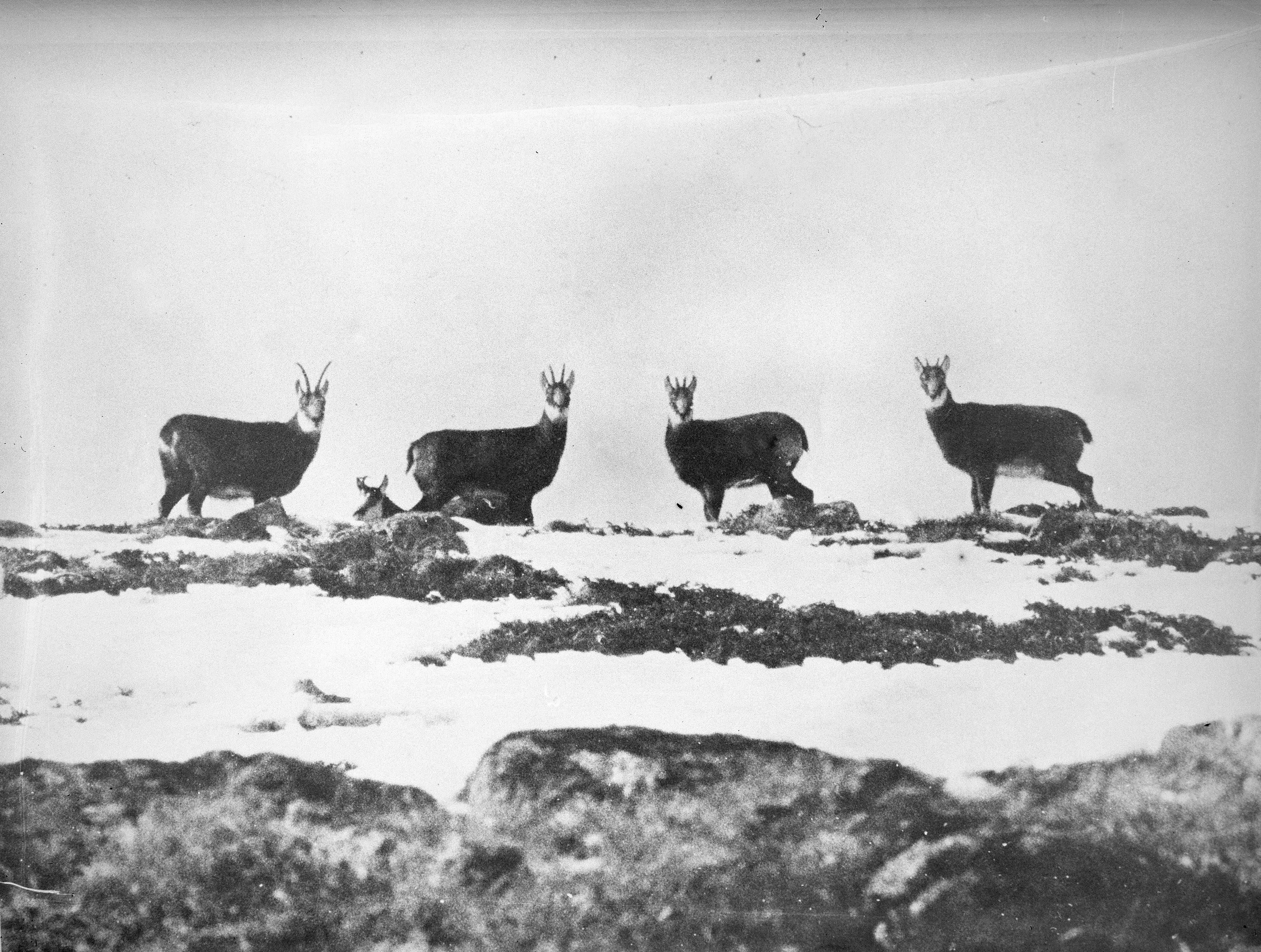Pioneer nature park marks centenary

The creation of the first nature reserve in the Alps 100 years ago - the Swiss National Park - had an enormous impact both in Switzerland and abroad. But experts say that the park’s rigorous approach to conservation would not be possible today.
A century ago, Senator Walter Bissegger advocated for the establishment of a pristine nature reserve in Switzerland. Addressing his fellow parliamentarians on March 25, 1914, he said: “The question that will have to be decided today is, in the end, one of a fundamental nature.”
“Do we want to create a sanctuary for plants and animals that is closed off as much as possible from all human influence, where the sound of an axe or a gun is no longer heard, and in which domesticated animals are prohibited from grazing?”
Parliament decided it did, paving the way for the founding of the first and only national park in Switzerland. Located in the eastern canton of Graubünden, it was officially inaugurated on August 1, 1914, Swiss National Day.
The national park is unique in that from the very beginning the highest priority was given to research. As all of the park’s founders happened to be nature experts, the reserve became the largest field laboratory in Switzerland, with areas left untouched – and thus handed over to nature – over a period of decades.
“Long-term research is especially important as it helps us to have a better understanding of the natural processes taking place,” writes the national park on its website.
Patrick Kupper, historian and author of Wildnis schaffen (Creating Wilderness), a book on the park’s founding, describes it is as “the prototype of a scientific national park”.
“It was referred to as an experiment, where people would observe how nature would develop if man left it alone,” he said.
European flagship
“It was a model for the whole of Europe, on the one hand embodying an uncompromising view of a strict protection of natural processes, and on the other advocating the protection of species,” explained Guido Plassmann, director of the Alpine Network of Protected Areas (ALPARC). In the Alps and in Europe, there are not enough of these types of nature sanctuaries, he said.
Matthias Stremlow of the Federal Environment Office described the reserve as “the flagship of Swiss parks”. He also pointed out it had “played a central role in the founding of the European national parks movement”.
Kupper agrees. Related movements in neighbouring countries such as France, Germany, Austria and Italy were very strongly based on the park, he said. A constant stream of foreign delegations came to the lower Engadine region to see the reserve firsthand.

More
The infancy of the Swiss National Park
Strong, stronger, strongest
The total protection of nature was of utmost importance to the park’s founders and the International Union for Conservation of Nature (IUCN), has designated the area the highest protection level “strict nature reserve”, category ‘Ia’.
In practical terms, this means that visitors cannot stray from the marked paths, take anything away or leave anything in the park, build fires, swim, or camp and cannot bring dogs into the park – in short, they cannot make any changes whatsoever. Park rangers are authorised to fine offenders.
That a park founded 100 years ago came to be protected so stringently had to do with industrialisation and the changes to society that this wrought, as well as with the development of Alpine tourism, said Kupper.
“People had the feeling that untouched regions would disappear from the face of the earth,“ he explained.
They were also fearful that man, in the midst of his relentless march forward at the turn of the century, would forget his own roots, his own origins, he added. Hence they wanted to safeguard the witnesses to the past – which was seen as including unspoiled nature – lest they forever disappear.
Hurdles
The park’s supporters found the perfect region for their project in the remote Val Cluozza. But there were obstacles to overcome.
Its decentralised location, directly on the Italian border, came in for criticism on nationalistic grounds – a national park should lie in the heart of Switzerland – and for fear of Italian poachers. A further hurdle was that the local population had to be won over.
Kupper says it was in fact a “stroke of luck” for the park that the First World War and French and German mobilisation were only just starting on the park’s founding day.
Funding probably would not have been given to the park by a parliament on a war footing, he said.
The first national park in Switzerland was supposed to be followed shortly thereafter by others, but the projects petered out. “Given the war, and then the interwar period, the establishment of nature reserves was not deemed a priority,” said Kupper. “So out of the first Swiss national park came ‘the’ Swiss National Park.”
The first national park in the world, Yellowstone National Park in Wyoming, in the United States, opened in 1872.
The national parks that followed came in Canada, Australia, New Zealand and South Africa. Large swaths of these parks still remain untouched.
The idea of a Swiss National Park was first broached and discussed in 1906, at the annual meeting of the Swiss Society of Natural Sciences.
Several society members founded the Swiss Conservation Committee. In 1908, on a field trip to the Ofen pass, under the leadership of Paul Sarasin, the committee’s attention was drawn to the uninhabited Cluozza valley.
In 1909 Sweden became the first European country to establish national parks in nine areas.
In the same year Sarasin and his fellow society members were able to lease land in the the Cluozza valley from Zernez and have it declared a “nature reserve.”
In 1911 Sarasin submitted a request to the government to subsidise the reserve. During that year and again in 1912 more leasing agreements were made with various municipalities in the Engadine.
The idea of incorporating a Swiss national park was first broached in parliament in March 1914 following studies by various federal agencies.
On August 1, 1914, Swiss National Day, the Swiss National Park was established as the first nature reserve in the Alps.
(Source: Patrick Kupper’s book Wildnis schaffen (Creating Wilderness)
More parks?
But it still makes sense to create national parks today, argues Stremlow. “The value of having landscapes in which nature is allowed to develop undisturbed by man is still of seminal importance, particularly also for biodiversity.”
Stremlow was referring, of course, to the two Swiss national parks in waiting: the Adula, which spans the cantons of Graubünden and Italian-speaking Ticino, and the Locarnese, in Ticino. Both have been awarded park candidate status, and as such have received financial support from the federal government, the cantons and local communities. Plassmann for his part is convinced that the creation of a second national park would be welcomed abroad, too.
The two parks are aiming for the nature reserve category known as national parks, which is category II. In contrast to wilderness parks, national parks prioritise regeneration and environmental education.
Today, said Plassmann, it would be extremely difficult to get protection status Ia, even if the country in question already had such a park. “The bar is set quite high,” he said.
Local roots
Winning over the locals has always been a challenge for national parks. The national park was “a typical top-down project, going from the centre to the periphery”, said Kupper. In this respect, he observed, today’s projects were fundamentally different.
Plassmann agreed: “nowadays you have to include the locals”.
Stremlow said that the government’s parks legislation makes support for a park project among the local population of central importance. “The creation of parks now follows a bottom-up process that entails approval at the lowest level before moving upwards,” he confirmed.
Thus, it is possible that, at long last, there will be another Swiss national park – more than a century after this was first envisioned by the current park’s founders.
“The chances are good,” says Stremlow.
To commemorate the centenary of the Park, organizers have published The Swiss National Park Atlas: the first 100 years.
The results of the first 100 years of scientific research are described, along with the spatial developments in and around the park.
An extension to the atlas available on the internet (see links) makes it possible to delve deeper into subjects covered in the book and allows interactive learning.
The Atlas was awarded the cartography prize “Prix Carto” by the Swiss Society of Cartography.
(Translated from German by Kathleen Peters)

In compliance with the JTI standards
More: SWI swissinfo.ch certified by the Journalism Trust Initiative











You can find an overview of ongoing debates with our journalists here . Please join us!
If you want to start a conversation about a topic raised in this article or want to report factual errors, email us at english@swissinfo.ch.